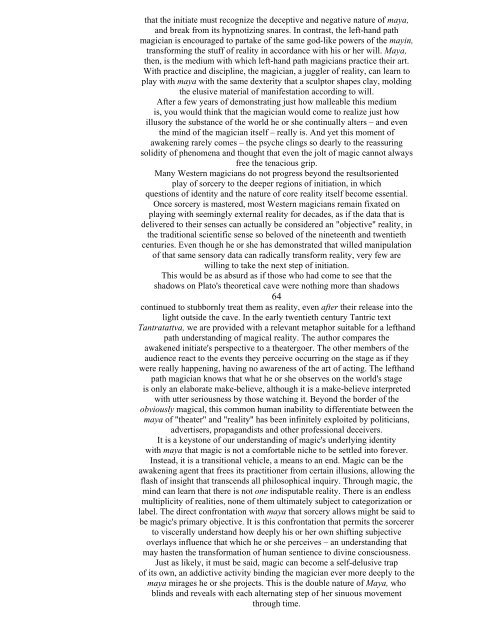I. VAMA MARGA Foundations Of The Left-Hand Path - staticfly.net
I. VAMA MARGA Foundations Of The Left-Hand Path - staticfly.net
I. VAMA MARGA Foundations Of The Left-Hand Path - staticfly.net
Create successful ePaper yourself
Turn your PDF publications into a flip-book with our unique Google optimized e-Paper software.
that the initiate must recognize the deceptive and negative nature of maya,<br />
and break from its hypnotizing snares. In contrast, the left-hand path<br />
magician is encouraged to partake of the same god-like powers of the mayin,<br />
transforming the stuff of reality in accordance with his or her will. Maya,<br />
then, is the medium with which left-hand path magicians practice their art.<br />
With practice and discipline, the magician, a juggler of reality, can learn to<br />
play with maya with the same dexterity that a sculptor shapes clay, molding<br />
the elusive material of manifestation according to will.<br />
After a few years of demonstrating just how malleable this medium<br />
is, you would think that the magician would come to realize just how<br />
illusory the substance of the world he or she continually alters – and even<br />
the mind of the magician itself – really is. And yet this moment of<br />
awakening rarely comes – the psyche clings so dearly to the reassuring<br />
solidity of phenomena and thought that even the jolt of magic cannot always<br />
free the tenacious grip.<br />
Many Western magicians do not progress beyond the resultsoriented<br />
play of sorcery to the deeper regions of initiation, in which<br />
questions of identity and the nature of core reality itself become essential.<br />
Once sorcery is mastered, most Western magicians remain fixated on<br />
playing with seemingly external reality for decades, as if the data that is<br />
delivered to their senses can actually be considered an "objective" reality, in<br />
the traditional scientific sense so beloved of the ni<strong>net</strong>eenth and twentieth<br />
centuries. Even though he or she has demonstrated that willed manipulation<br />
of that same sensory data can radically transform reality, very few are<br />
willing to take the next step of initiation.<br />
This would be as absurd as if those who had come to see that the<br />
shadows on Plato's theoretical cave were nothing more than shadows<br />
64<br />
continued to stubbornly treat them as reality, even after their release into the<br />
light outside the cave. In the early twentieth century Tantric text<br />
Tantratattva, we are provided with a relevant metaphor suitable for a lefthand<br />
path understanding of magical reality. <strong>The</strong> author compares the<br />
awakened initiate's perspective to a theatergoer. <strong>The</strong> other members of the<br />
audience react to the events they perceive occurring on the stage as if they<br />
were really happening, having no awareness of the art of acting. <strong>The</strong> lefthand<br />
path magician knows that what he or she observes on the world's stage<br />
is only an elaborate make-believe, although it is a make-believe interpreted<br />
with utter seriousness by those watching it. Beyond the border of the<br />
obviously magical, this common human inability to differentiate between the<br />
maya of "theater" and "reality" has been infinitely exploited by politicians,<br />
advertisers, propagandists and other professional deceivers.<br />
It is a keystone of our understanding of magic's underlying identity<br />
with maya that magic is not a comfortable niche to be settled into forever.<br />
Instead, it is a transitional vehicle, a means to an end. Magic can be the<br />
awakening agent that frees its practitioner from certain illusions, allowing the<br />
flash of insight that transcends all philosophical inquiry. Through magic, the<br />
mind can learn that there is not one indisputable reality. <strong>The</strong>re is an endless<br />
multiplicity of realities, none of them ultimately subject to categorization or<br />
label. <strong>The</strong> direct confrontation with maya that sorcery allows might be said to<br />
be magic's primary objective. It is this confrontation that permits the sorcerer<br />
to viscerally understand how deeply his or her own shifting subjective<br />
overlays influence that which he or she perceives – an understanding that<br />
may hasten the transformation of human sentience to divine consciousness.<br />
Just as likely, it must be said, magic can become a self-delusive trap<br />
of its own, an addictive activity binding the magician ever more deeply to the<br />
maya mirages he or she projects. This is the double nature of Maya, who<br />
blinds and reveals with each alternating step of her sinuous movement<br />
through time.
















